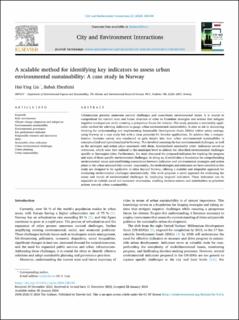| dc.contributor.author | Liu, Hai Ying | |
| dc.contributor.author | Ebrahimi, Babak | |
| dc.date.accessioned | 2024-02-16T09:15:56Z | |
| dc.date.available | 2024-02-16T09:15:56Z | |
| dc.date.created | 2024-02-05T13:23:34Z | |
| dc.date.issued | 2024 | |
| dc.identifier.uri | https://hdl.handle.net/11250/3118091 | |
| dc.description.abstract | Urbanization presents numerous societal challenges and exacerbates environmental issues. It is crucial to comprehend the current state and future direction of cities to formulate strategies and actions that mitigate negative consequences while ensuring a prosperous future for citizens. This study presents a universally applicable method for selecting indicators to gauge urban environmental sustainability. It aims to aid in structuring thinking for understanding and implementing Sustainable Development Goals (SDGs) within urban settings, using Norway as a case study but with a clear potential for broader applications. To achieve this, a comprehensive literature survey was conducted to gain insight into how urban environmental sustainability is conceptualized and operationalized in Norway. This involved assessing the key environmental challenges, as well as the strategies and action plans associated with them. Standardized sustainable cities' indicators served as references, which were then tailored to the municipal level to address the identified environmental challenges specific to Norwegian cities. Furthermore, the study discussed the proposed indicators for tracking the progress and state of these specific environmental challenges. In doing so, it establishes a foundation for comprehending environmental issues and establishing connections between indicators and environmental strategies and action plans in the urban sustainability context. Importantly, the methodologies and indicators we have unveiled in this study are designed to be applicable to cities beyond Norway, offering a scalable and adaptable approach for evaluating environmental challenges internationally. This work proposes a novel approach for evaluating the status and trends of environmental challenges by employing targeted indicators. These indicators can be expanded to include social and economic dimensions, enabling decision-makers and stakeholders to prioritize actions towards urban sustainability. | en_US |
| dc.language.iso | eng | en_US |
| dc.rights | Navngivelse 4.0 Internasjonal | * |
| dc.rights.uri | http://creativecommons.org/licenses/by/4.0/deed.no | * |
| dc.title | A scalable method for identifying key indicators to assess urban environmental sustainability: A case study in Norway | en_US |
| dc.title.alternative | A scalable method for identifying key indicators to assess urban environmental sustainability: A case study in Norway | en_US |
| dc.type | Peer reviewed | en_US |
| dc.type | Journal article | en_US |
| dc.description.version | publishedVersion | en_US |
| dc.rights.holder | © 2024 The Authors. Published by Elsevier Ltd. | en_US |
| dc.source.volume | 22 | en_US |
| dc.source.journal | City and Environment Interactions | en_US |
| dc.identifier.doi | 10.1016/j.cacint.2024.100144 | |
| dc.identifier.cristin | 2243270 | |
| dc.relation.project | NILU: 120012 | en_US |
| dc.source.articlenumber | 100144 | en_US |
| cristin.ispublished | true | |
| cristin.fulltext | original | |
| cristin.qualitycode | 1 | |

